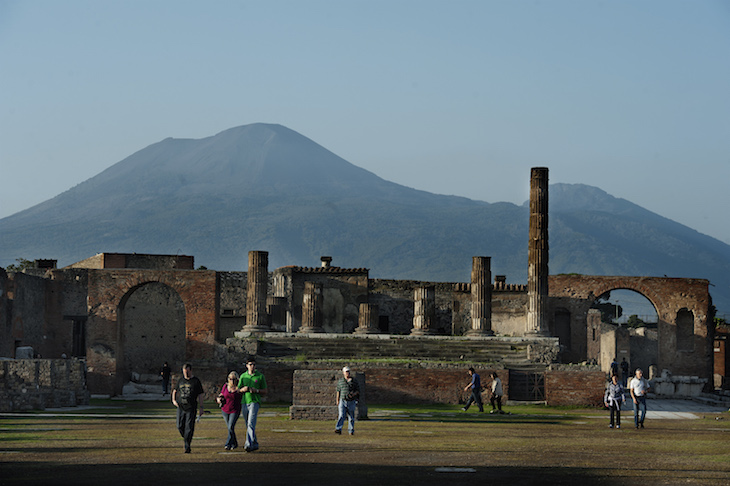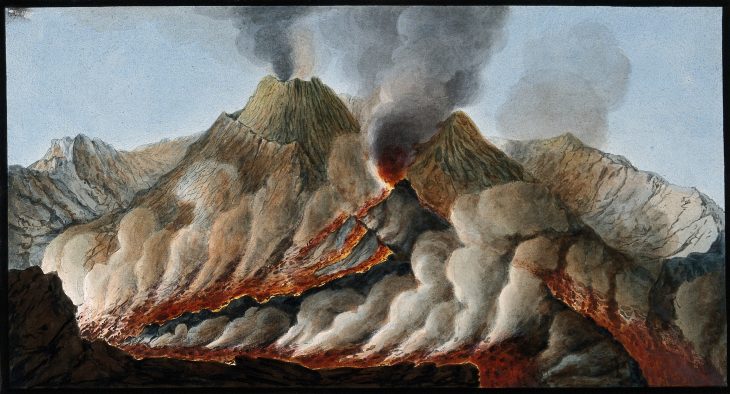Walking through Pompeii today will transport you back to the bustling streetscape of 2,000 years ago. Decorated stone buildings flank the paved streets, rutted by the wear-and-tear of urban traffic. Vesuvius, the volcano that entombed the city and thousands of its inhabitants, lurks in the distance. It has been quiet since 1944.
Many archaeological sites fall slowly into ruin: repurposed through generations of urban change, or overrun by the creep of the jungle or the shifting sands of the desert. Pompeii, in contrast, is a city frozen in time and preserved in exquisite detail by the pyroclastic avalanches that spread over the city ‘like a flood’ at the climax of the great eruption of 79 AD. The pumice and ash that engulfed the city that day still cover nearly a third of the city. Pliny’s eyewitness accounts of the eruption, and the preservation of the city in its last moments, mean that this extraordinary site can tell us not only about everyday Roman life and culture, but also about the sequence of physical events as the eruption unfolded.
There are many challenges facing those with responsibility for this world heritage site. How to preserve buildings that were freed from their ashy cocoon a century or more ago, but are now starting to crumble? How to balance the desire to explore more of what remains buried, with obligations to preserve the site for future generations? Recently, some volcanologists have proposed that the volcanic deposits that are intrinsic to the site are not being preserved well enough in situ. Without Vesuvius there would be no Pompeii, yet the imprint of Vesuvius is barely discernible at street level.

Tourists visit the archaeological site of Pompeii. Photo: Roberto Salomone/AFP/Getty Images
After the eruption, what was left of Pompeii was buried under three metres of ash and pumice. Here and there, fragments of rooflines and truncated or toppled columns might have been visible across the ash-grey landscape. With the inhabitants either dead, or dispersed, the location of the city faded from view, and from memory.
In 1631 Vesuvius burst back to life, with a flurry of hot pyroclastic avalanches and mud flows. For the next 300 years, while activity waxed and waned, Vesuvius became a focal point for adventurous visitors. In 1638, the Jesuit scholar Athanasius Kircher climbed to the summit, peered into the fiery crater, and pondered the workings of the subterranean world. As the discovery of the buried treasures of Pompeii and Herculaneum attracted the attention of collectors of antiquities, the protective volcanic covering was tunnelled, then excavated, revealing the towns once more. William Hamilton, British envoy-extraordinary to King Ferdinand, found much to occupy him around Naples. His close observations of the dramatic eruptions of Vesuvius in 1767, published in his Campi Phlegraei (1776), attracted interest back in London, while on his visits to the emerging site of Pompeii he saw how the layers of pumice, ash and soil could be read as the products of violent past eruptions, separated by long gaps of time.

Mount Vesuvius: interior of the crater showing the flow of lava in an eruption Coloured etching by Pietro Fabris (1776), after his painting (1756), published in William Hamilton’s Campi Phlegraei. Wellcome Library (used under a Creative Commons Licence [CC BY 4.0])
After the end of the Napoleonic Wars, travellers flocked to the Bay of Naples to experience the sublime views, ‘retrace the lives of the ancients’, and thrill at the horror of the smoking crater. Vesuvius proved to be the perfect natural laboratory for scientists to test new ideas on the nature of volcanoes and the origins of lava, heat and fire. Crystalline fragments of rock dragged up from the Earth’s interior and lurid condensates from volcanic fumes frequently provided new discoveries for early mineralogists. In 1841, Vesuvius became the site of the world’s first volcano observatory, stimulating new innovations in the measurement of volcanic earthquakes, sound and electricity. Today, Vesuvius is quiet, but closely monitored, with the tiniest of tremors deep beneath the volcanoes tracked with the most recent generation of seismograph.
There are more secrets to be uncovered from the ashes of Pompeii that could help us to prepare for future eruptions. In 79 AD, hot dense avalanches of pumice and ash swirled through the urban landscape, engulfing the victims in searing hot ash. As the flows spread across the city, buildings and other obstacles left their imprint on the deposits that enclose them. The volcanic deposits preserve in intimate detail the time sequence of those fateful few hours. In the same way that archaeological investigations of the city continue to enrich our appreciation of Roman lives and lifestyles, forensic analysis of the deposits and computer simulations of the flows that preserved the city can provide invaluable information about how pyroclastic currents move through cities.
David Pyle is a professor of Earth Sciences at the University of Oxford.

Unlocking the secrets of Vesuvius
Interior view of the crater of Mount Vesuvius, as it was before the eruption of 1767; detail of a plate in William Hamilton, Campi Phlegraei (1776). Getty Research Institute, Los Angeles; photo courtesy the Getty’s Open Content Program
Share
Walking through Pompeii today will transport you back to the bustling streetscape of 2,000 years ago. Decorated stone buildings flank the paved streets, rutted by the wear-and-tear of urban traffic. Vesuvius, the volcano that entombed the city and thousands of its inhabitants, lurks in the distance. It has been quiet since 1944.
Many archaeological sites fall slowly into ruin: repurposed through generations of urban change, or overrun by the creep of the jungle or the shifting sands of the desert. Pompeii, in contrast, is a city frozen in time and preserved in exquisite detail by the pyroclastic avalanches that spread over the city ‘like a flood’ at the climax of the great eruption of 79 AD. The pumice and ash that engulfed the city that day still cover nearly a third of the city. Pliny’s eyewitness accounts of the eruption, and the preservation of the city in its last moments, mean that this extraordinary site can tell us not only about everyday Roman life and culture, but also about the sequence of physical events as the eruption unfolded.
There are many challenges facing those with responsibility for this world heritage site. How to preserve buildings that were freed from their ashy cocoon a century or more ago, but are now starting to crumble? How to balance the desire to explore more of what remains buried, with obligations to preserve the site for future generations? Recently, some volcanologists have proposed that the volcanic deposits that are intrinsic to the site are not being preserved well enough in situ. Without Vesuvius there would be no Pompeii, yet the imprint of Vesuvius is barely discernible at street level.
Tourists visit the archaeological site of Pompeii. Photo: Roberto Salomone/AFP/Getty Images
After the eruption, what was left of Pompeii was buried under three metres of ash and pumice. Here and there, fragments of rooflines and truncated or toppled columns might have been visible across the ash-grey landscape. With the inhabitants either dead, or dispersed, the location of the city faded from view, and from memory.
In 1631 Vesuvius burst back to life, with a flurry of hot pyroclastic avalanches and mud flows. For the next 300 years, while activity waxed and waned, Vesuvius became a focal point for adventurous visitors. In 1638, the Jesuit scholar Athanasius Kircher climbed to the summit, peered into the fiery crater, and pondered the workings of the subterranean world. As the discovery of the buried treasures of Pompeii and Herculaneum attracted the attention of collectors of antiquities, the protective volcanic covering was tunnelled, then excavated, revealing the towns once more. William Hamilton, British envoy-extraordinary to King Ferdinand, found much to occupy him around Naples. His close observations of the dramatic eruptions of Vesuvius in 1767, published in his Campi Phlegraei (1776), attracted interest back in London, while on his visits to the emerging site of Pompeii he saw how the layers of pumice, ash and soil could be read as the products of violent past eruptions, separated by long gaps of time.
Mount Vesuvius: interior of the crater showing the flow of lava in an eruption Coloured etching by Pietro Fabris (1776), after his painting (1756), published in William Hamilton’s Campi Phlegraei. Wellcome Library (used under a Creative Commons Licence [CC BY 4.0])
There are more secrets to be uncovered from the ashes of Pompeii that could help us to prepare for future eruptions. In 79 AD, hot dense avalanches of pumice and ash swirled through the urban landscape, engulfing the victims in searing hot ash. As the flows spread across the city, buildings and other obstacles left their imprint on the deposits that enclose them. The volcanic deposits preserve in intimate detail the time sequence of those fateful few hours. In the same way that archaeological investigations of the city continue to enrich our appreciation of Roman lives and lifestyles, forensic analysis of the deposits and computer simulations of the flows that preserved the city can provide invaluable information about how pyroclastic currents move through cities.
David Pyle is a professor of Earth Sciences at the University of Oxford.
Unlimited access from just $16 every 3 months
Subscribe to get unlimited and exclusive access to the top art stories, interviews and exhibition reviews.
Share
Recommended for you
Hedonism in Herculaneum – a guide to good living in a luxurious Roman villa
The Villa dei Papiri gives us a glimpse into the world of a Roman statesman and his interest in Epicurean philosophy
The age of spectacular finds at Pompeii is far from over
The Great Pompeii Project’s restoration of the site has led to a stream of exciting discoveries
What can contemporary artists do for the ruins of Pompeii?
The sensitive juxtaposition of old and new could revive some of the site’s more neglected artefacts